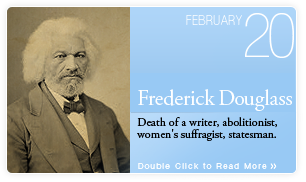Death of Frederick Douglass
On this day in 1895, Frederick Douglass–writer, abolitionist, women’s suffragist, statesman–passed away in his home in Washington, D.C. He was born Frederick Augustus Washington Bailey circa 1818 in Maryland as a slave. Separated from his family members repeatedly, he eventually ended up in Baltimore, Maryland in the household of Hugh Auld. Although teaching a slave to read was illegal at the time, Auld’s wife Sophia began teaching him the alphabet at age 12. He persisted and learned to read and began devouring all the written material he could, including newspapers, books and political tracts. Hired out to another owner, he began teaching other slaves to read at that plantation, often having more than 40 slaves in attendance to learn. After neighbours stormed his teaching sessions, he was returned to his original owner Thomas Auld, brother of Hugh. Thomas sent him to a farmer, Edward Covey, whose harsh treatment of his slaves had labeled him a “slave-breaker.” Having been mistreated by Covey for some time, Douglass, now 16, fought back against Covey, beating him to the point that he never tried to assault Douglass again. In 1838, on his second attempt to escape, he succeeded, taking a train while disguised as a sailor. He traveled straight up to New York City, and later, describing his feelings upon arrival, said “A new world had opened upon me…I lived more in one day than in a year of my slave life. It was a time of joyous excitement which words can but tamely describe.” He moved up to Massachusetts and immediately became involved in the abolitionist movement. By 1843 he was on a six-month tour of the country lecturing against slavery on behalf of the American Anti-Slavery Society. In 1845 he published his most famous work, The Narrative of the Life of Frederick Douglass, An American Slave. In 1848 he attended the women’s rights oriented Seneca Falls Convention, powerfully speaking about how women deserved political rights and winning the convention over to adopt a resolution calling for women’s suffrage. By the outbreak of the Civil War, Douglass was the most famous black man in America. He rallied around the North’s side, working in recruitment. During Reconstruction he was president of the failed Freedman’s savings Bank, and after that worked for the state department as a diplomat to Haiti and Dominican Republic. On February 20, 1895, shortly before he died, Douglass attended a meeting of the National Council of Women during which he came on stage and received a full standing ovation. Throughout his life, he was fond of saying, “I would unite with anybody to do right and with nobody to do wrong.”

